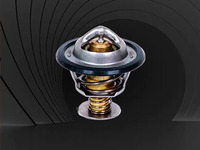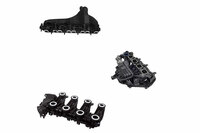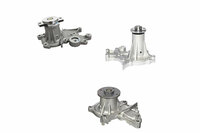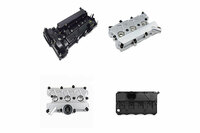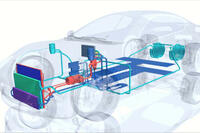Automotive Car Electric Thermostat
Product Quick Detail
- FOB Price
- USD $200.00 / Piece
- Minimum Order
- 1
- Place Of Origin
- china
- Packaging
- N/A
- Delivery
- 15 Days
Specifications
Automotive electric thermostat maintains the temperature of the engine near its optimum operating temperature by regulating the flow of coolant to an air-cooled radiator. The performance of
automotive car electric thermostats is crucial to engine lifespan. Car engine coolant thermostat technology is constantly accelerating. SDZ accumulated a wealth of experience and intuitive
technology with so much research and development in car cooling system thermostats from wax thermostats, Map-Controlled Thermostat to Motor Ball Valve Thermostat and coolant temperature sensor
housing. For more automotive cooling system components at wholesale price.
SDZ Automotive Car Electric Thermostat
Automotive Car Electric Thermostat Function
With increasing demands on vehicle dynamics, the efficiency of engine cooling systems is critical. As a key component of the automobile engine cooling system, the automotive electronic thermostat
is mainly used to control the flow path and flow of engine coolant, which directly affects the efficiency of the cooling system.
How Does the Car Thermostat Function?
The automotive car electric thermostat operates based on the principle of thermal expansion. It contains a wax pellet that expands when it heats up, causing a valve to open and allowing coolant to
flow through the engine. When the coolant cools down, the wax pellet contracts and the valve closes, restricting the flow of coolant.
The thermostat such as a wax thermostat is designed to maintain the engine's temperature within a specific range, typically between 180 and 220 degrees Fahrenheit. If the engine is too cold, the
automotive car electric thermostat will restrict the flow of coolant to allow the engine to warm up quickly. Once the engine reaches its optimal temperature, the automotive car electric thermostat
will open fully, allowing coolant to flow freely through the engine and maintain its temperature.
If the engine becomes too hot, the automotive car electric thermostat will open wider to allow more coolant to flow through the engine, helping to cool it down. If the engine continues to overheat,
the automotive car electric thermostat may be faulty, and it should be replaced.
Why is the Thermostat Important in a Car?
The vehicle thermostat mainly functions in regulating the engine's temperature, which is essential for the engine's proper functioning. If the engine is too cold, it may not operate efficiently,
resulting in increased fuel consumption and emissions. If the engine becomes too hot, it can cause damage to the engine components, leading to costly repairs.
Maintaining the Thermostat in Your Car
Proper maintenance of the automotive car electric thermostat is crucial for ensuring your engine operates smoothly. Here are some tips to help you maintain your car's automotive cooling system
components and help the thermostat function properly:
Regular Inspection: Check the electronically controlled thermostat for any signs of wear or damage, such as cracks or corrosion.
Flushing the Cooling System: Regularly flushing the cooling system can help remove any debris that may clog the electronically controlled thermostat and reduce its efficiency.
Using the Right Coolant: Using the correct type of coolant for your car's engine is essential for maintaining the thermostat's efficiency.
Replacing the electronically controlled thermostat: If the thermostat is faulty or damaged, it should be replaced promptly to prevent damage to the engine.
Electronically Controlled Thermostat FAQs
Part 01
What is the work of thermostat in a car
A electronically controlled thermostat is a device that is designed to regulate the temperature of a system by controlling the flow of a heating or cooling agent. The primary vehicle thermostat
function is to maintain a set temperature range by switching on and off a heating or cooling system as needed.
Automotive car electric thermostats are commonly used in residential and commercial heating and cooling systems to regulate the temperature inside a building. They work by sensing the temperature
in the environment and sending signals to the heating or cooling system to turn on or off based on the temperature reading.
Electronically controlled thermostats are also used in many other applications, such as refrigerators, ovens, and water heaters, to regulate the temperature of the system and maintain a consistent
temperature range. By maintaining a consistent temperature, automotive car electric thermostats help to improve energy efficiency, reduce energy costs, and extend the lifespan of heating and
cooling systems.
Part 02
How to replace electronically controlled thermostat?
When the automotive electronic thermostat needs to be replaced, you need to turn on the engine's cooling system on the one hand, which causes some engine coolant to escape, on the other hand, some
air into the system. In order to eliminate these pockets, the cooling system should be thoroughly and carefully vented after the automotive electronic thermostat is replaced.
Part 03
How Does Automotive Car Electric Thermostat Work in Engine Cooling System?
The traditional thermostat assembly made by auto engine parts factory is mainly composed of the shell and the automotive car electric thermostat inside the shell, usually the cooling water
circulation of the engine includes large circulation and small circulation, large circulation and small circulation share a water outlet, through the electronic automotive thermostat opening and
closing large circulation water inlet for large circulation start and stop control.
SDZ Car Cooling System Thermostat Quality
- Opening/Full Temperature
- High /Low-temperature Test
- Durability
- Hysteresis
- Sealing test
- Valve Leakage Test
- Burst test
- Tensile Test
- Drop Test
- Aging Test
- Salt Spray Test
- Flow Characteristics
As an engine parts factory, we can offer sorts of car engine parts for sale, if you have needs, please contact us.
- Country: China (Mainland)
- Business Type: Manufacturer
- Founded Year: 2013
- Address: No.9, Haohai RD, Xinbang Industrial Zone, Songjiang, Shanghai, China
- Contact: SDZ com

